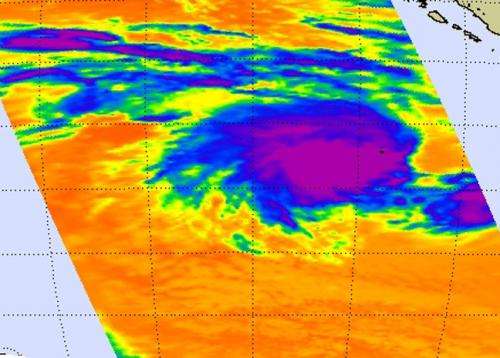NASA spots active Southern Indian Ocean's Tropical Storm 18S

The eighteenth tropical cyclone of the Southern Indian Ocean season formed over the weekend of Feb. 23-24 along with Cyclone Rusty as Cyclone Haruna crossed southern Madagascar. NASA's Aqua satellite measured Tropical Storm 18S' cloud top temperatures and saw powerful thunderstorms around the storm's core.
Cyclone Rusty is nearing a landfall in northwestern West Australia, while Tropical Storm 18S is headed in a similar direction.
Tropical Storm 18S (TS18S) was born on Feb. 24 and achieved tropical storm strengthe with maximum sustained winds near 35 knots (40 mph). It formed about 45 nautical miles southeast of the Cocos Islands, Australia near 12.7 south latitude and 97.3 east longitude.
Wind shear on Feb. 24 was affecting the storm, and pushing the strongest thunderstorms west of the center. NASA's TRMM satellite captured data on rainfall and noted the strongest rainfall was occurring west of the center at a rate of more than 1.4 inches per hour.
On Feb. 24 at 0729 UTC (2:29 a.m. EST), the Atmospheric Infrared Sounder (AIRS) instrument aboard NASA's Aqua satellite captured infrared data on TS18S. The data was created into a false-colored image at NASA's Jet Propulsion Laboratory in Pasadena, Calif. False coloration enables meteorologists to see distinction in temperatures, and the coldest temperatures and highest cloud tops (and strongest thunderstorms) appeared in a large area around TD18S's center. Cloud top temperatures around the center exceeded the -63 Fahrenheit (-52 Celsius) threshold, indicating that those areas were likely dropping heavy rainfall.
Satellite data has shown that wind shear is still affecting the tropical storm, and pushing the main convection to the west. That wind shear is expected to persist over the next couple of days before easing up.
On Feb. 25 at 1500 UTC (10 a.m. EST) Tropical Storm 18S was located about 980 nautical miles (1,128 miles/1,815 km) west-northwest of Learmonth, Australia, near 14.7 south and 99.0 east. TS18S had maximum sustained winds near 35 knots (40.2 mph/64.8 kph) and was moving to the southeast near 6 knots (6.9 mph/11.1 kph).
Forecasters at the Joint Typhoon Warning Center expect TS18S to take an easterly track, toward Port Hedland and Learmonth, Western Australia after the second of March. If that occurs, the residents of northwestern Australia will be recovering from Cyclone Rusty when Tropical Storm 18S approaches.
Provided by NASA's Goddard Space Flight Center



















